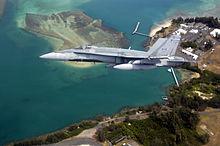This is an old revision of this page, as edited by Dolphin51 (talk | contribs) at 22:53, 14 April 2011 (Added "See also". Added links to Mach tuck and Grumman X-29. Copy-edit.). The present address (URL) is a permanent link to this revision, which may differ significantly from the current revision.
Revision as of 22:53, 14 April 2011 by Dolphin51 (talk | contribs) (Added "See also". Added links to Mach tuck and Grumman X-29. Copy-edit.)(diff) ← Previous revision | Latest revision (diff) | Newer revision → (diff)


In aerodynamics, pitch-up is a severe form of stall in an aircraft. It is directly related to inherent properties of all swept wings.
History
Pitch-up problems were first noticed on high-speed test aircraft with swept wings. It was a common problem on the Douglas Skyrocket, which was used extensively to test the problem.
Before the pitch-up phenomenon was well understood, it plagued all early swept-wing aircraft. In the F-86 Sabre it even got its own name, the Sabre dance. In aircraft with high-mounted tailplanes, like the F-101 Voodoo, recovery was especially difficult because the tailplane was placed directly in the wing wake during the pitch-up, causing deep stall. Deployment of the braking parachute and a considerable height above the ground were essential for a chance at recovery.
Description
The wingtips of a swept wing aircraft operate at a higher local lift coefficient than inboard sections of the wing so the wingtips are more heavily loaded than inboard sections. In addition, swept wings tend to generate spanwise flow of the boundary layer (along the length of the wing from root to tip rather than across the wing from front to back). This problem is primarily seen at low speeds. The combination of these factors means that at a high angle of attack, especially at low speed, the wingtips stall before the rest of the wing.
Since the wingtips of a swept wing are, by definition, farther back than the wing roots, wingtip stall results in a considerable forward shift of the center of pressure relative to the center of mass. The result is a rapid upwards pitch of the aircraft nose. If the tailplanes of an aircraft are caught in the resultant wake coming off the wings, they may not have enough authority to recover horizontal flight and the aircraft will continue to nose up higher and higher. In some circumstances, the aircraft can actually tumble end over end, sometimes at supersonic speeds, and the recovery may be difficult or impossible. Sometimes an intentional rapid pitch-up of the nose by the pilot, such as in a high speed hairpin turn in a fighter jet, will cause the aircraft to become uncontrollable and it may begin to tumble.
Mitigation
As the primary causes of the pitch-up problem are due to spanwise flow and more loading at the tips, measures to address these issues can eliminate the problem. In early designs these were typically "add-ons" to an otherwise conventional wing planform, but in modern designs this is part of the overall wing design and normally controlled via the existing high-lift devices.
A common solution to the problem of spanwise flow is the use of a wing fence or the related dogtooth notch on the leading edge of the wing. This disrupts the flow and re-directs it rearward, while also causing the buildup of stagnant air inboard to lower the stall point. This does have an effect on overall airflow on the wing, and is generally not used where the sweep is mild. To address the problems with loading, a wider variety of techniques have been used, including dedicated slats or flaps, the use of washout or automated control of the ailerons. An unusual solution tried on the XF-91 Thunderceptor prototype fighter was to give the wingtips a wider chord than the wing roots. The idea was to increase wingtip lift and cause the wing roots to stall first.
Angle of attack sensors on the aircraft can also detect when the angle of attack approaches the attitude known to result in pitch-up and activate devices like the stick shaker to warn the pilot, and the stick pusher which overpowers the pilot and forces the nose of the aircraft down to a safer angle of attack. Twist or washout built into the wingtips can also alleviate pitch-up. In effect, the angle of attack at the wingtip becomes smaller than elsewhere on the wing, meaning that the inboard portions of the wing will stall first.
A commonly-used solution to pitch-up in modern combat aircraft is to use a control-canard. Another modern solution to pitch-up is the use of slats. When slats are extended they increase wing camber and increase maximum lift coefficient.
Pitch-up is impossible in aircraft with forward-swept wings as used on the Grumman X-29. With forward-swept wings the spanwise flow is inboard, causing the wing root to stall before the wingtip. One might imagine this could lead to the possibility of pitch-down problems, but the onset of this effect would lower angle of attack, and thus eliminate the problem.
See also
References
- Loftin, LK, Jr. "Quest for performance: The evolution of modern aircraft. NASA SP-468". Retrieved 2006-04-22.
{{cite web}}: CS1 maint: multiple names: authors list (link)
Notes
- ^ Clancy, L.J. (1975), Aerodynamics, Sub-section 11.19(a), Pitman Publishing Limited, London. ISBN 0 273 01120 0
- Raymer, Daniel P. (1989), Aircraft Design: A Conceptual Approach, Section 4.5 - Tail geometry and arrangement. American Institute of Aeronautics and Astronautics, Inc., Washington, DC. ISBN 0-930403-51-7
- Clancy, L.J. (1975), Aerodynamics, Section 6.9